My first “specklebelly”, ever.
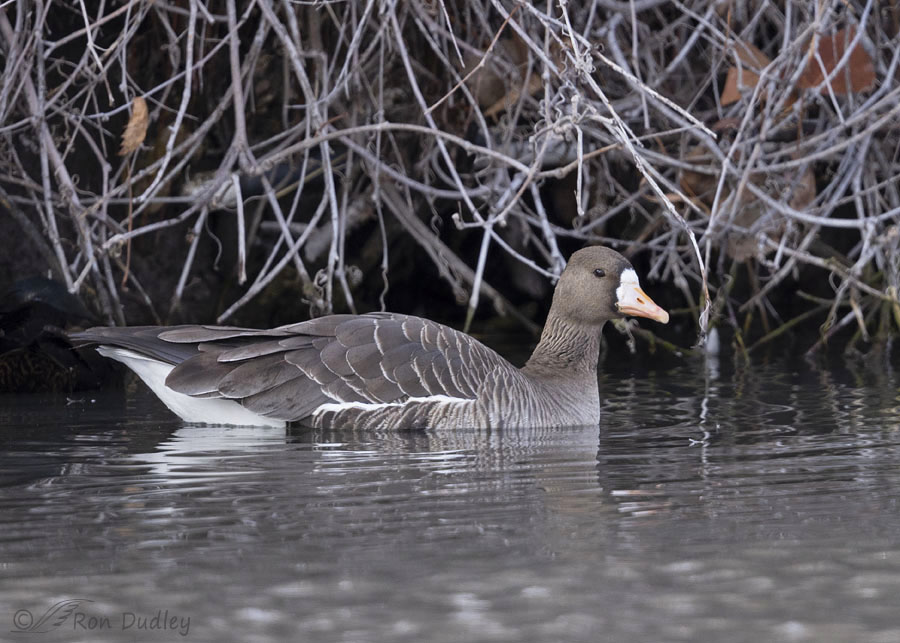
Yesterday morning I was fortunate enough to spend some quality time with the first Greater White-fronted Goose I’ve ever seen, much less photographed. In Utah this species is unusual, a vagrant, so you can imagine my excitement.
This is one of the first shots I took of ‘him’, while he was resting in the deep shade against the bank. Just before I took this photo he’d been sleeping.
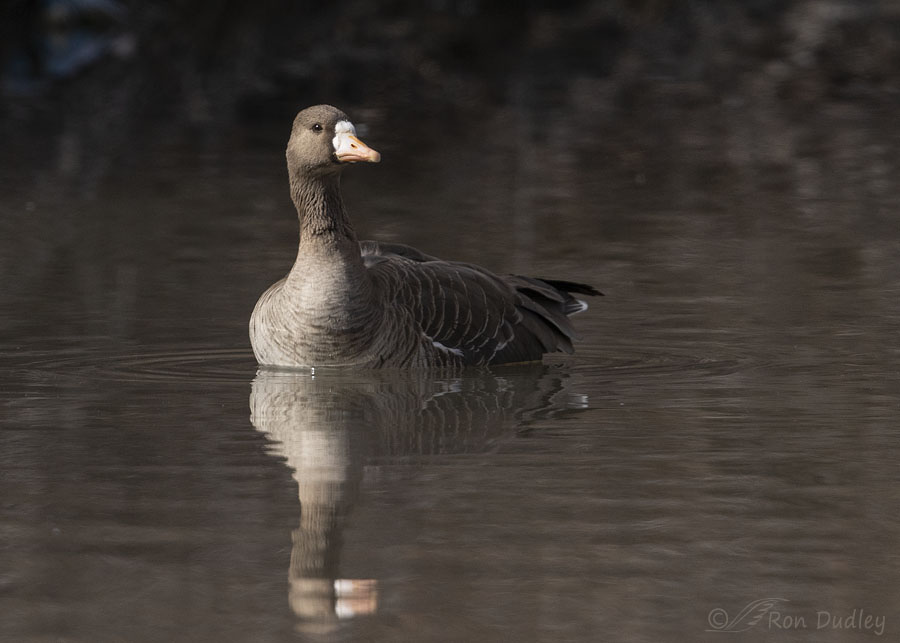
When he first came out into the light, light that was intermittent and fairly brief, he was sidelit.
But I still like the shot, in part because it shows that his “white-front”, the white feathers between his bill and eyes, is actually mostly feathers rather than a white portion of the proximal part of his bill. The proximal portion of his bill is also white-ish but it’s less white, as you’ll see best in one of the photos below.
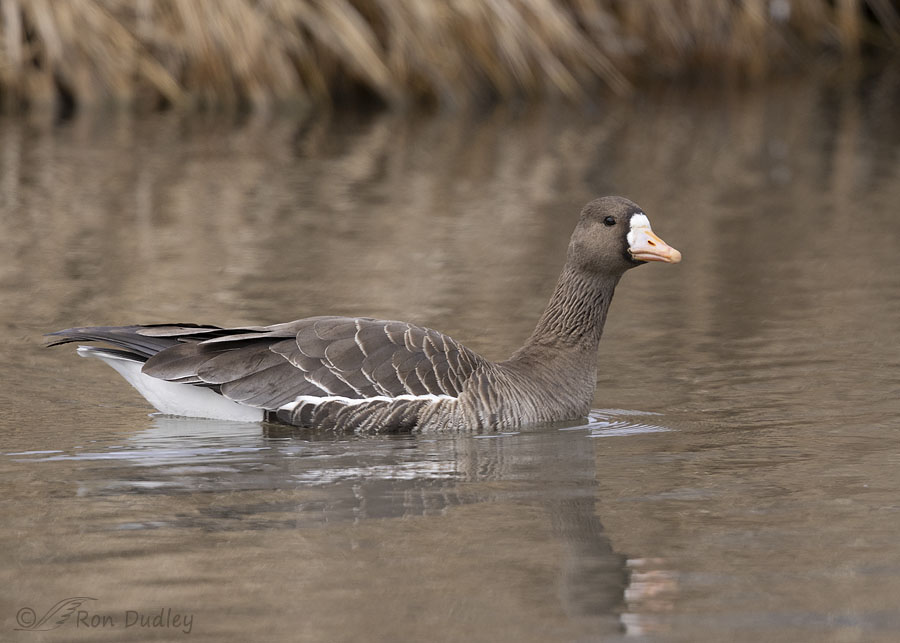
The photos I took of him while the sun was behind clouds turned out better than I thought they would.
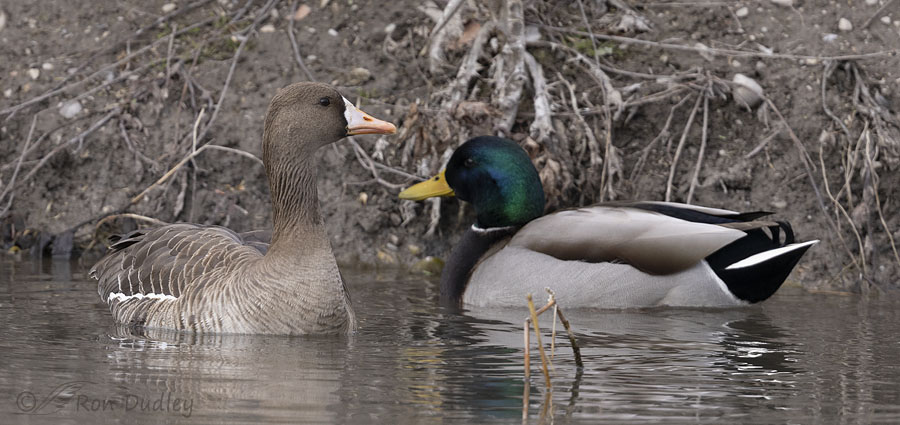
I’m only including this shot of him next to a Mallard so readers can get a sense of relative size. Specklebellies are a little less than half the size of Canada Geese (4.8 lbs. vs 9.8 lbs.)
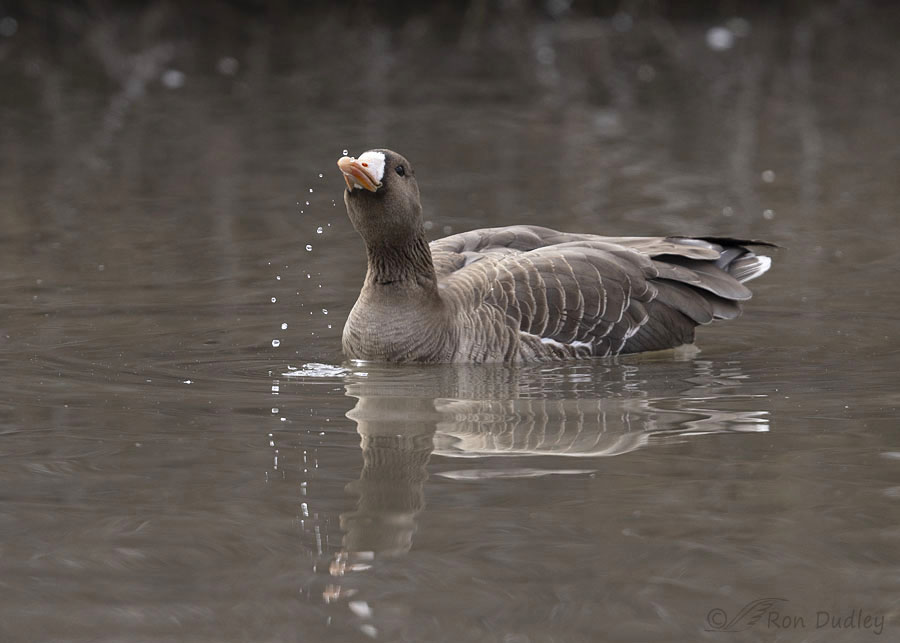
Getting a drink.
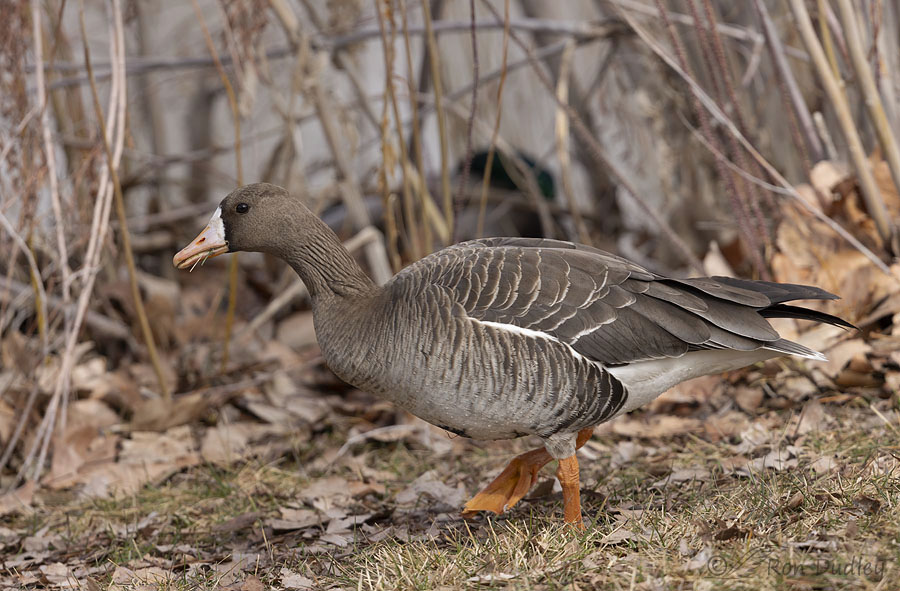
Near the end of my time with him he came up on land for a short while. This is one of the few shots I got of him that allows us to see his legs and one of his feet. Yes, he’d been grazing on grass.
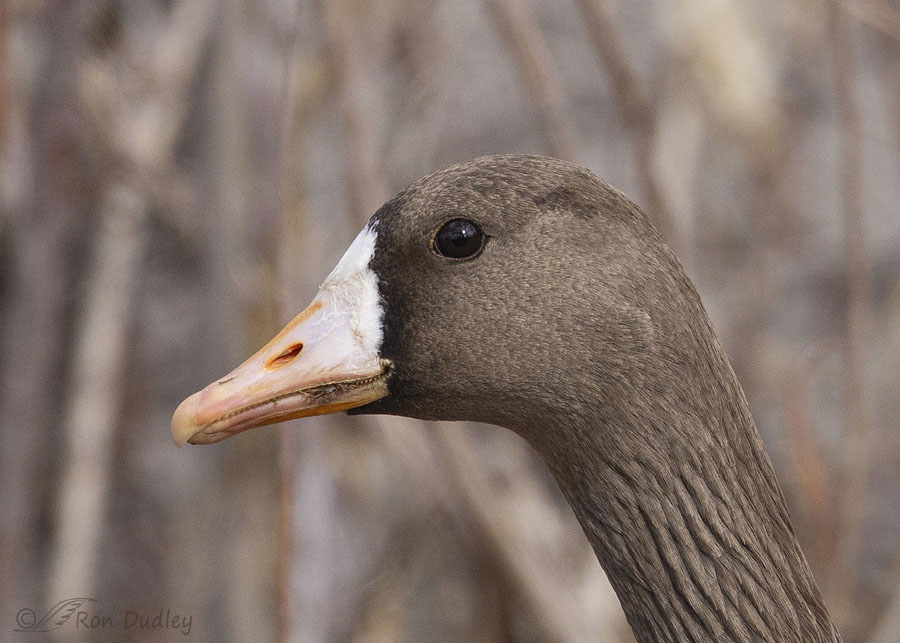
A portrait, for head and neck detail.
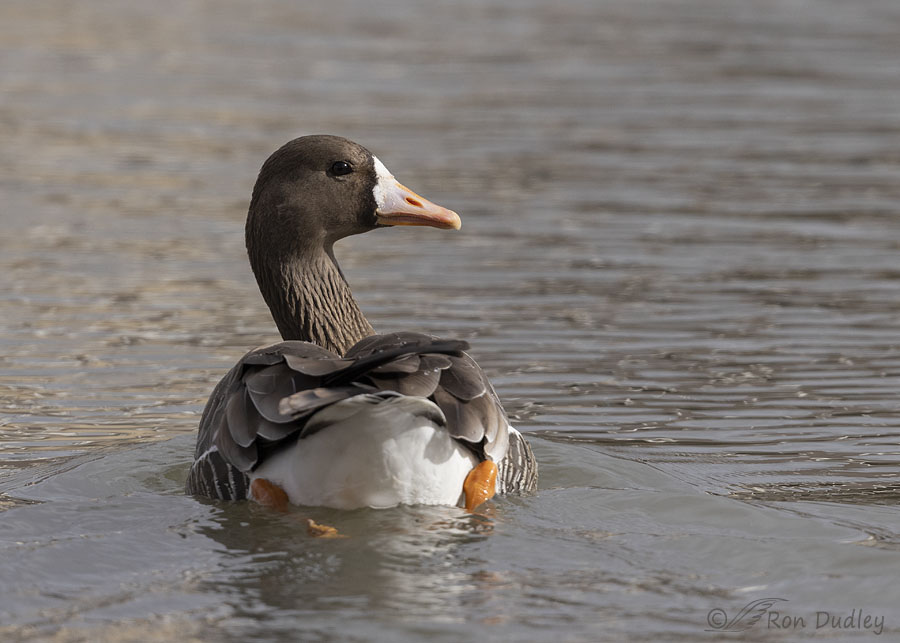
When he got back into the water and swam away from me he gave me a look-back that I like, even though it’s a butt shot. Sometimes sidelight just works.
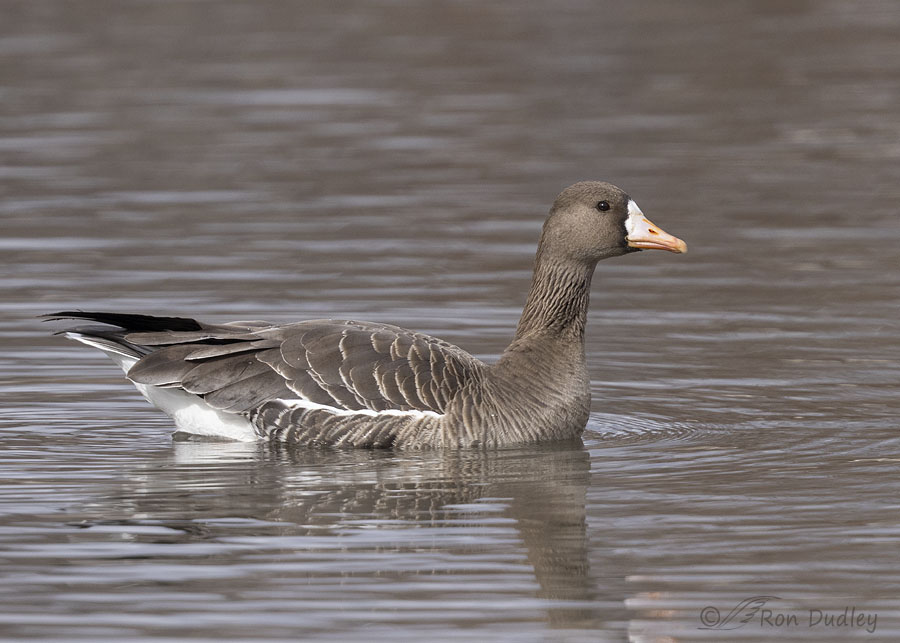
I’ll close with one of the few shots i got of him with the sun behind me.
Waterfowl hunters call this species “specklebellies” because of the dappled black markings on their creamy light breast, markings that resemble those on birch or aspen trees. I never did get any photos that show those markings very well. Maybe next time.
Ha, as if there’s likely to be a next time…
Ron


A lovely series from a fortunate happenstance. Great to see one of your “firsts” Ron.
Thank you, Brett.
Excellent series!!
A new to me bird. What fun!
Thanks, Arwen. New to me also.
How exciting!!! He is a looker for sure! That over-the-shoulder glance as he’s swimming away from you makes for one of the best butt-shots I’ve ever seen. I also greatly appreciate all the detail the portrait provides — those are some interesting-looking “teeth.”
That over-the-shoulder glance as he’s swimming away from you makes for one of the best butt-shots I’ve ever seen. I also greatly appreciate all the detail the portrait provides — those are some interesting-looking “teeth.”
Hope you guys aren’t also in the path of the snow dump that CO is getting from our Thursday storm. Considering the flooding we had last week (that even made some of the national news), I’m not looking forward to the next 3 days here.
P.S. I should have said “our city” instead of “we” — fortunately, “we” are on relatively high ground, so unless the river or creek/flood control burst the banks, I think only a bit of the garage will feel the brunt.
Thanks, Marty. Sunny and a little breezy today but then we’ve got 2-3 days of rain coming in after that. This time of year rain in the valleys means snow in the mountains, so it’s a good thing.
I’ve been reading about your CA storms. Batten down the hatches!
Fun find and wonderful photos.
Thanks, April.
It’s aways fun to see something new, especially if you can get nice photos of them. Here in Oregon they are a common migrant and winter species in many locations. My best photo op was several years ago in the Klamath Basin. It was on property of a resort so no hunting was permitted and the birds were standing next to a road leading out of the resort area. This was very much a wild flock but the birds showed little fear. They were used to cars driving by and there was probably safety in numbers. There were many flocks throughut the valley but this particular flock must have had more than 2,000 birds. I often see them at a distance so this was a very nice treat to see so many within just a few feet of my car window. i hope you have other opportunities. This is an attractie species.
Wow, Dan. 2K of them. I can’t imagine.
Thanks for a very good look at a species I have never had the opportunity to spot outdoors. And I always appreciate the info you provide.
Thanks on both counts, Burrdoo.
Beautiful creature! So glad he came close enough for you to study him. He actually looks pretty relaxed in your photos. And the comparison to the mallard is very helpful. I love his “portrait” – the details are stunning.
Thanks, Carolyn. i had to do some pretty “creative” driving to get that portrait but it was worth it.
That is an unusual species for this area. Must have blown in from California or Oregon on the winds. Years ago at the Hagerman wildlife refuge in Southern Idaho there was a duck native to Japan that appeared and birders by the dozens staked out on the refuge to get a once in a lifetime photo opportunity. What a madhouse.
“What a madhouse.”
Steven, that’s exactly why I didn’t, and won’t, reveal the location of this goose. That’s the last thing he needs. It may happen anyway, but if it does I don’t want to be responsible for it.
Ron – PS – like that you included the photo with the Mallard that shows the size difference, but of course when they stand up out of the water a much greater difference,
I’m glad you appreciated that shot, Everett.
Wow – these outstanding photos so humble me. We have a few White-fronted here from time to time and I have taken photos of them, but none like these. You give an outstanding photographer a Canon R5 and this is what you get. Excellent photography Ron.
The most I have ever seen here were 5 on the golf course in the snow and rain.
Thanks for the very kind and generous words, Everett.
I just got lucky with this bird yesterday. Before that he’d always been much too far away for quality photos.
What a handsome bird he is ! I liked shot # 1 for the harmony
that the light-colored, curving branches lend -they visually echo the edging of his feathers– and I also liked your capture of him drinking–the arc of droplets in the air add sparkle to the serenity of the scene. So glad that you “got” him !
Kris, I tried often to get shots that included flying or falling water drops while he was drinking or shaking his head. I thought that one was the best I got, especially when I cropped to include the reflection of the water drops.
Marvelous. I’m so happy for you; you deserve another First!
Thanks very much, Cheryl. I can’t remember the last time I got a ‘lifer’.
New one to me tho I see they do migrate through here! Sounds indicate I’ve probably heard them….. Pretty goose that, I’m sure, casual observers would take for “a duck of some sorts” The serated upper bill is interesting and, I’m sure, useful for eating the grass.
The serated upper bill is interesting and, I’m sure, useful for eating the grass. 
Some wet snow this morning tho don’t know how much the still frozen ground will take.
“casual observers would take for “a duck of some sorts””
I’m pretty sure you’re right about that, Judy.
This goose has been around for nearly a week now (although until yesterday he was always far away) and as far as I know, nobody but three of us has recognized him as anything unusual. I’m sure that folks who do spot him think he’s just another duck of some kind.
Good catch Ron! Quite an event to get a life bird. Like the comparison shot. Being a goose, I had imagined it much larger.
Like that third shot because of the way the head is slightly turned. And for the same reason, that butt shot, as far as butt shots go, is good.
Thanks, Michael. Flattering head turns are, or can be, as important as catch lights in eyes.
A lovely series from a fortunate happenstance. Great to see one of your “firsts” Ron.
Thank you, Brett.